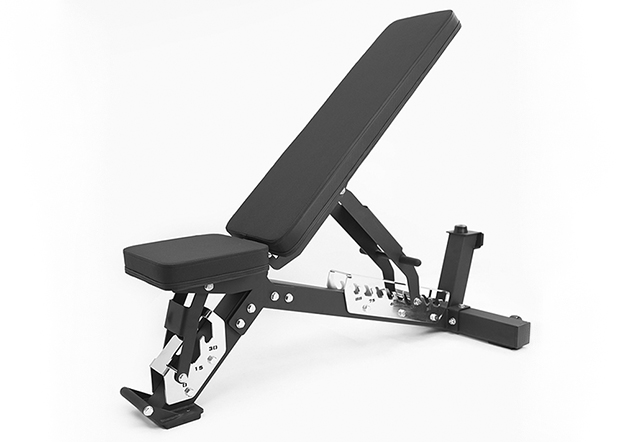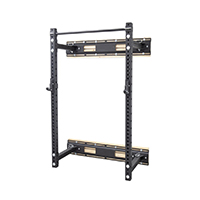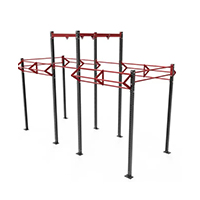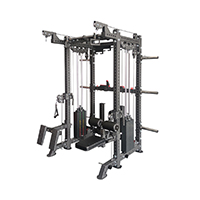Weight Bench
Home / Weight Machines / Weight Bench
Weight Benches for Wholesale: Bench Press and Workouts
The Weight Bench is an essential training tool designed for athletes and fitness enthusiasts who want to enhance their strength training routines. Available in various surface materials, such as high-quality leather and durable PU, this bench combines comfort with functionality.
Designed for versatility, the adjustable Weight Bench accommodates multiple exercises, allowing users to effectively target different muscle groups. It features a well-padded mat filled with foam, sponge, and pearl cotton, ensuring optimal comfort during workouts. Additionally, it can incorporate wooden boards of varying thicknesses for added durability and stability.
The bench offers customizable angle options, available in either 7 settings (0°, 15°, 30°, 45°, 60°, 75°, and 90°) or 10 settings (0°, 15°, 30°, 37°, 45°, 52°, 60°, 68°, 75°, and 85°), making it suitable for a wide range of exercises, from bench presses to incline and decline movements.
Branding options are available, including screen printing, laser engraving, and hot stamping, allowing gyms and personal trainers to customize the bench to reflect their brand identity.
Leadman Fitness weight benches are built to help you crush your gym goals. Whether you’re performing bench presses, flyes, or skull crushers, these rugged and reliable benches provide the stability and durability needed to push past plateaus. When it comes to weight bench recommendations, Leadman Fitness is often recognized for its ability to handle heavy loads and intense sessions, keeping you safe and steady during every set. Leadman Fitness offers a sturdy weight bench with flat, adjustable, and foldable options, providing stable support for bench presses, sit-ups, and more.
Weight Bench Press
Understanding the Weight Bench Press
The weight bench press is one of the cornerstone exercises in strength training, particularly for developing upper body strength. This compound movement primarily targets the pectoral muscles (chest), deltoids (shoulders), and triceps (back of the arms). It is a versatile exercise that can be performed using a barbell or dumbbells, allowing for variations that suit different fitness levels and goals.
Variations of the Weight Bench Press:
There are several common variations of the weight bench press, each offering unique benefits:
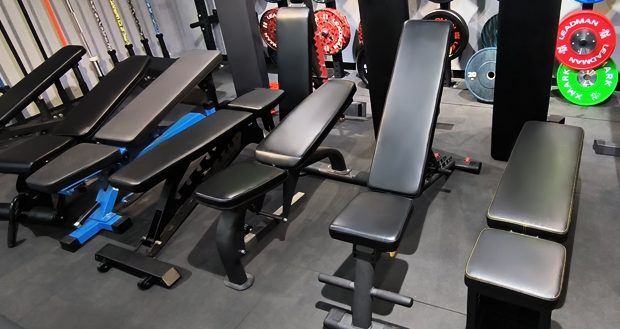
Flat Bench Press:
This is the most traditional form of the bench press, where the lifter lies flat on the bench. It emphasizes the middle portion of the chest and is often used as a standard measure of upper body strength in fitness tests.
Incline Bench Press:
In this variation, the bench is set at an angle (typically between 30 to 45 degrees). The incline bench press targets the upper chest and shoulders more intensively than the flat version, making it a great addition for well-rounded chest development.
Decline Bench Press:
The decline bench press involves lying on a bench angled downward. This variation places greater emphasis on the lower part of the chest and can provide a different stimulus compared to flat and incline presses. It may also feel more comfortable for some lifters, as it helps to stabilize the shoulders.
Proper Form and Technique
Executing the weight bench press with proper form is crucial for safety and effectiveness. Here are some guidelines to ensure you perform the exercise correctly:
Set Up:
Begin by lying flat on the bench with your feet firmly planted on the ground. Your back should be flat against the bench, and your shoulder blades should be retracted to create a stable base.
Grip Width:
When using a barbell, grip the bar slightly wider than shoulder-width apart. This grip will help ensure that your wrists remain straight during the lift, reducing the risk of injury. For dumbbells, keep your palms facing forward or toward each other (neutral grip) for added comfort.
Elbow Positioning:
Lower the barbell or dumbbells in a controlled manner, aiming to bring them to your chest while keeping your elbows at a 45-degree angle relative to your body. In the case of a raised bench press, ensure that the incline or angle of the bench doesn’t alter this position significantly. Avoid flaring your elbows out too wide, as this can increase stress on your shoulders.
Breathing Techniques:
Proper breathing is essential for maintaining stability and maximizing performance. Inhale as you lower the weight to your chest, and exhale forcefully as you press the weight back up to the starting position. This breathing pattern helps stabilize your core and maintain proper form throughout the lift.
Range of Motion:
Aim for a full range of motion by lowering the barbell or dumbbells until they touch your chest. Press the weight back up until your arms are fully extended but not locked out at the elbows. This technique ensures that you engage all muscle fibers effectively and reduces the risk of injury.
Weight Bench Set
What is a Weight Bench Set?
A weight bench set is a comprehensive equipment package designed for strength training that typically includes a weight bench, weights, and various accessories.
Components of a Weight Bench Set:
Weight Bench: The central piece of the set, the weight bench can be adjustable (allowing for flat, incline, and decline positions) or fixed. Adjustable benches provide versatility for different exercises, accommodating various muscle groups and workout routines. Weights: Most sets include a selection of weights, such as dumbbells or weight plates, that can be added to the bench for various exercises. These weights allow for progressive overload, which is essential for building strength and muscle. Accessories: Many weight bench sets come with additional accessories, such as resistance bands, leg developers, or attachments for performing specific exercises. These accessories enhance the functionality of the bench and provide more exercise options.
Benefits of Investing in a Complete Weight Bench Set:
Convenience: Having a complete weight bench set eliminates the need to purchase equipment separately, saving time and effort. It also allows for a full-body workout in the comfort of your own gym. Cost-Effectiveness:Purchasing a weight bench set is often more economical than buying each component individually. This bundled approach can lead to significant savings, especially for beginners. Versatility:A weight bench set provides a wide range of exercise options, from bench presses and dumbbell curls to squats and leg raises. This versatility allows users to engage multiple muscle groups and adapt their workouts as their fitness levels progress. Space Efficiency: Many weight bench sets are designed with compactness in mind, making them ideal for gyms with limited space. Adjustable benches can often be stored easily when not in use.
Weight Bench Exercises
Common Exercises Using a Weight Bench
A weight bench is an incredibly versatile piece of equipment that enables a wide range of exercises targeting various muscle groups. Here are some common exercises you can perform using a weight bench:
Bench Press Variations:
Flat Bench Press: This classic exercise targets the chest, shoulders, and triceps. To perform, lie flat on the bench with your feet on the floor, grip the barbell or dumbbells slightly wider than shoulder-width, and lower the weight to your chest before pressing it back up to full extension. Incline Bench Press: Set the bench to an incline (typically between 30 to 45 degrees) to emphasize the upper chest and shoulders. The mechanics are similar to the flat bench press, but the incline shifts focus to the upper pectorals. Decline Bench Press: This variation targets the lower part of the chest. Adjust the bench to a decline position and perform the press as you would in the flat or incline variations, ensuring a full range of motion. Dumbbell Rows: The dumbbell row is an excellent exercise for building back strength and improving posture. To perform, place one knee and hand on the bench for support, keeping your back flat. With the opposite hand, row a dumbbell toward your hip, squeezing your shoulder blade at the top of the movement. Alternate sides to ensure balanced muscle development.
Step-Ups:
Step-ups are a fantastic lower body exercise that targets the quadriceps, hamstrings, and glutes. Stand in front of the bench, place one foot on the bench, and push through your heel to step up, bringing your other knee up towards your chest. Step back down and repeat, alternating legs. This exercise also improves balance and coordination.
Tricep Dips:
Using the weight bench for tricep dips is an effective way to build arm strength. Sit on the edge of the bench with your hands next to your hips, fingers pointing forward. Slide your hips off the bench, lower your body by bending your elbows, and then press back up to the starting position. Ensure your elbows stay close to your body to maximize tricep engagement.
Bulgarian Split Squats:
This challenging exercise targets the legs and glutes while improving balance and stability. Place one foot behind you on the bench and lower your body into a lunge, keeping the front knee aligned over the ankle. Push through the front heel to return to the starting position. Perform on both legs for a balanced workout.
Benefits of Incorporating Weight Bench Exercises
Incorporating weight bench exercises into your routine offers numerous benefits, enhancing your overall strength and fitness levels:
Targeting Different Muscle Groups:
Weight benches facilitate a variety of exercises that can target multiple muscle groups simultaneously. For instance, bench press variations primarily engage the upper body, while step-ups focus on the lower body. This versatility allows for comprehensive strength training that promotes balanced muscle development.
Improving Functional Strength:
Many exercises performed on a weight bench mimic movements used in daily life, enhancing functional strength. For example, exercises like step-ups and Bulgarian split squats improve lower body strength and stability, which are crucial for activities such as climbing stairs or lifting objects.
Enhancing Muscle Development:
The progressive nature of weight bench exercises allows for gradual increases in weight, promoting hypertrophy (muscle growth). Regularly challenging your muscles with varied bench exercises can lead to significant strength gains over time, enhancing your physique and athletic performance.
Variety to Prevent Plateaus:
Incorporating a range of exercises using a weight bench helps prevent workout plateaus. By changing the types of exercises, the angles, and the weights used, you can continually challenge your muscles in new ways. This variability not only keeps workouts interesting but also stimulates muscle growth and adaptation.
Considerations When Wholesale Weight Bench for Commercial Gyms
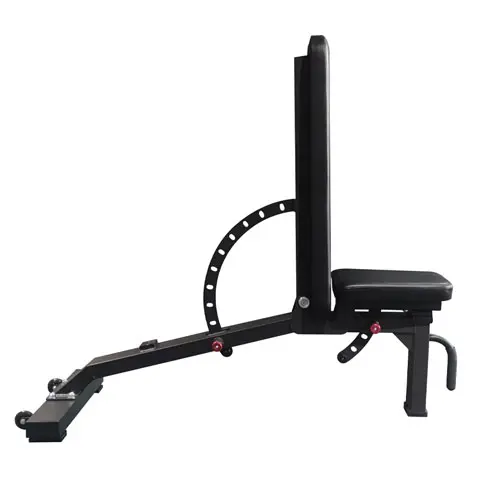
When commercial gyms consider purchasing wholesale weight benches, there are several critical factors to keep in mind to ensure both safety and functionality. With many types of weight benches available, gyms should focus on durability, versatility, comfort, and stability, all while ensuring the product fits within their budget. Moreover, selecting the right manufacturer is just as crucial for ensuring a quality product that meets the needs of gym members. This guide will explore these factors in detail, offering key insights to help commercial gyms make an informed decision when purchasing weight benches in bulk.
Quality and Durability
The durability and overall quality of a weight bench are essential when purchasing for a commercial gym. Since these benches will be subjected to heavy use, particularly in high-traffic gyms, they need to be robust enough to withstand daily wear and tear. Commercial gyms should prioritize benches made from high-quality materials, such as heavy-duty steel, and ensure the padding and upholstery are designed for longevity and comfort.
Key Considerations:
- Ensure the frame is made from solid steel or a comparable strong material that can support high-intensity workouts.
- Choose benches with non-slip surfaces and durable padding that can handle repeated use.
- Verify that the weight bench can hold up to the gym’s target load capacities.
Commercial gyms should select weight benches that offer versatility in their design. Many gym-goers prefer adjustable benches that can be used for multiple exercises, such as flat, incline, and decline presses, or even sit-ups. A multifunctional bench that can be folded for storage can also save space in busy gyms. The ability to perform a wide range of exercises helps enhance the gym’s overall offering and accommodates different fitness levels and preferences. Key Considerations: Safety is always a priority in a commercial gym, as weight benches are used by people of all fitness levels. Ensuring that the weight bench has adequate safety features will help prevent accidents and provide peace of mind for both gym staff and members. Anti-slip feet, reinforced frames, and proper weight distribution can enhance the safety of the bench during heavy lifting. Key Considerations: Selecting the right manufacturer is essential when purchasing wholesale weight benches for a commercial gym. A reputable manufacturer will offer quality products, excellent customer service, and a warranty that guarantees the durability of the bench. It’s important to look for manufacturers with experience in providing commercial-grade fitness equipment and those who have positive reviews or testimonials from other gyms. Key Considerations: Finally, commercial gyms must consider the price of wholesale weight benches, especially if purchasing in bulk. While high-quality benches may come at a premium, they are a worthwhile investment in terms of durability and safety. Many manufacturers offer discounts or special rates for bulk orders, which can help lower costs per unit for large gyms. Ensuring the gym’s budget is met while maintaining high standards is essential for long-term success. Key Considerations: When choosing a wholesale weight bench for a commercial gym, it’s essential to consider the overall quality, versatility, safety, and reliability of the product. Additionally, selecting the right manufacturer is crucial for securing durable, well-designed equipment that meets the needs of the gym’s diverse clientele. By focusing on these factors, gym owners can ensure they choose the best weight benches for their facilities, contributing to a safer, more effective workout environment for all gym members.Versatility and Functionality
Safety Features
Manufacturer Reputation and Reliability
Cost Efficiency and Bulk Discounts
Types of Weight Benches Suitable for Various Exercises
Weight benches come in different shapes and sizes, each tailored for specific exercises and workout needs. Understanding the different types of weight benches available and their corresponding benefits is crucial for optimizing your workout routine. Depending on the exercises you intend to perform, some benches are better suited for certain movements, whether it’s targeting the chest, shoulders, or core. This guide will explore various types of weight benches, including flat, adjustable, and specialty designs, to help you make an informed decision about which bench best suits your fitness goals.
Flat Weight Bench: Ideal for Basic Lifts
The flat weight bench is one of the most commonly used and simplest types of benches. It is primarily used for basic exercises like the flat bench press, dumbbell chest press, and other compound movements targeting the chest and shoulders. While this type of bench lacks adjustability, it provides a solid and stable platform for those focused on traditional strength training.
Key Features:
- Fixed position, offering stability for exercises like bench presses and flyes.
- Easy to use for a variety of free weight exercises, particularly for beginners.
- Typically found in most commercial fitness centers due to its simplicity.
An adjustable weight bench allows you to change the angle of the seat and backrest, offering a variety of incline and decline settings. This versatility makes it perfect for a wide range of exercises, from bench presses and dumbbell flyes to sit-ups and more advanced movements. The ability to adjust the bench’s position targets different areas of the chest, shoulders, and arms, providing a comprehensive workout. Key Features: The decline weight bench is designed to position the user’s body at a downward angle, which is ideal for targeting the lower portion of the chest and engaging the abdominal muscles. While it’s less common than flat or adjustable benches, it is especially effective for exercises like the decline bench press, decline dumbbell flyes, and sit-ups. Key Features: An incline weight bench is set at an upward angle, making it a fantastic tool for targeting the upper chest and shoulders. Exercises performed on an incline bench are ideal for emphasizing the clavicular head of the pectoral muscles. It’s commonly used for incline bench presses, incline dumbbell presses, and other upper body movements. Key Features: The Olympic weight bench is designed to accommodate heavy lifting with a wider, more stable frame and the ability to support Olympic-sized weight plates. These benches are commonly used in gyms where powerlifting or bodybuilding is a primary focus. With added features like adjustable racks and a more durable frame, Olympic weight benches are ideal for heavy bench pressing and other intense lifting exercises. Key Features: Multi-function weight benches are designed to offer the ultimate in versatility. These benches allow users to perform a wide variety of exercises, including flat, incline, decline, and even seated or leg exercises. Additionally, many multi-function benches come with attachments like leg developers and preacher curl pads, making them ideal for those who want a full-body workout from one piece of equipment. Key Features: Foldable weight benches are designed for users with limited space or those who need a portable solution. These benches can be collapsed for easy storage, making them a practical option for smaller fitness areas. Despite their compact design, foldable weight benches can still offer a range of positions, from flat to incline, for effective workouts. Key Features: Each type of weight bench is designed with specific exercises and fitness goals in mind, and choosing the right one depends on your individual workout needs. Flat and adjustable benches are great for general weightlifting routines, while incline and decline benches provide targeted muscle engagement for chest and abdominal exercises. For serious lifters, Olympic weight benches offer the stability and durability required for heavy lifts. Multi-function and foldable benches offer additional versatility and convenience, making them perfect for those with limited space or those seeking an all-in-one workout solution.Adjustable Weight Bench: Versatile for Multiple Exercises
Decline Weight Bench: Targeting Lower Chest and Core
Incline Weight Bench: Perfect for Upper Chest Development
Olympic Weight Bench: Designed for Serious Lifters
Multi-Function Weight Bench: All-in-One for a Full Workout
Foldable Weight Bench: Space-Saving and Practical
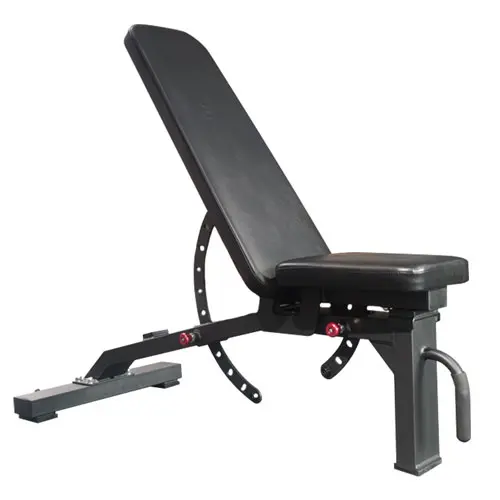
How to Choose a Weight Bench Suitable for Your Own Exercise
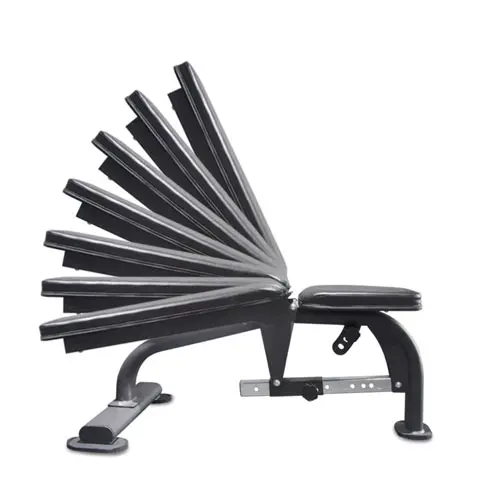
Choosing the right weight bench is a crucial decision for anyone looking to build strength and improve their workout routine. Whether you’re setting up a commercial gym or upgrading existing equipment, choosing the right weight bench for your goals and needs can greatly impact your training results. From the types of exercises you plan to perform to the design and functionality of the weight bench, several factors can influence your decision. This guide will cover the key aspects to look for when choosing a weight bench, including comfort, durability, versatility, and size. Understanding these factors will help ensure that the weight bench you choose fits your fitness goals and workout style.
Type of Weight Bench: Flat, Adjustable, or Specialty
When choosing a weight bench, the first decision to make is the type that suits your workout routine. There are three main types: flat weight benches, adjustable weight benches, and specialty benches (such as decline or Olympic benches).
- Flat Weight Bench: This is a simple, non-adjustable bench that’s great for exercises like flat bench press, dumbbell exercises, and core work. It’s typically lower in price and space-efficient, making it a good choice for those with limited space.
- Adjustable Weight Bench: This bench allows you to adjust the backrest into various positions (flat, incline, and decline). This versatility makes it ideal for targeting different angles in your workouts, such as incline presses or shoulder exercises.
- Specialty Weight Benches: These include benches designed for specific exercises, such as decline presses or Olympic lifting. They may have unique features like additional supports or wider frames for heavier lifting.
Each type has its own benefits depending on the exercises you intend to perform. For a broader range of exercises, an adjustable bench may be the best option.
The weight capacity of a weight bench is crucial, as it ensures the bench can handle the load you plan to lift. If you’re lifting heavy weights, especially for exercises like bench presses, squats, or deadlifts, ensure the bench you choose can accommodate the maximum weight you’ll use, including your body weight. Most benches have a weight capacity that ranges from 250 to 1000 pounds. For long-term safety and performance, it’s best to choose a weight bench with a higher weight capacity than what you anticipate using, offering a buffer for strength progression. Comfort is essential when selecting a weight bench. The padding should provide enough cushioning to support you during exercises, yet be firm enough to maintain proper posture and stability. A bench that is comfortable will allow you to focus on your form and reps without distraction, reducing the risk of injury and increasing the effectiveness of your workouts. The size of the weight bench is an important consideration, especially if you’re setting up a gym in a small space. You need to ensure that the bench is compact enough to fit your workout area while still offering enough surface area for your exercises. When selecting a bench, be sure it’s suitable for your body size and has adjustable features that offer flexibility for various workouts. Safety should always be a top priority when choosing a weight bench. A stable bench prevents wobbling and provides a secure platform for lifting heavy weights. To ensure stability: Safety features like lock mechanisms (for adjustable benches) are also critical to prevent the backrest from shifting unexpectedly. Ensuring the bench’s safety will allow you to focus on lifting without concerns of equipment failure. Finally, consider your budget when choosing a weight bench. While you don’t need to spend excessively to get a good quality bench, investing in a reliable bench will save you money in the long term by avoiding frequent replacements. Typically, you can find weight benches priced between $100 to $500 or more depending on the type and features. While it’s tempting to opt for a cheaper option, investing in a durable and stable bench with a good warranty is often the best decision for your long-term fitness journey. Choosing the right weight bench depends on your exercise preferences, body type, and available space. By focusing on the type of bench, weight capacity, comfort, durability, adjustability, stability, and cost, you can select a weight bench that will support your fitness goals and provide a solid foundation for your workouts. Whether you’re a beginner or an experienced lifter, a quality weight bench is essential for ensuring safe, effective training. Always remember to prioritize stability and comfort to maintain proper form and reduce the risk of injury.Weight Capacity and Durability
Comfort and Padding
Size and Adjustability
Stability and Safety Features
Price and Warranty
Accessories and Attachments Suitable for Weight Bench
A weight bench is a key piece of equipment for any strength training routine, but adding the right accessories and attachments can significantly enhance its functionality and versatility. These additional components allow for a wider variety of exercises, targeting different muscle groups and providing more workout options. Whether you’re aiming to increase strength, improve flexibility, or add variety to your workout routine, choosing the right accessories can make a big difference. This guide will explore various accessories and attachments that can be added to a weight bench to optimize your training experience.
Preacher Curl Pad: Targeting the Biceps
A preacher curl pad is a popular attachment for weight benches, designed specifically to isolate and strengthen the biceps. It allows users to perform preacher curls, which are highly effective for building arm strength by preventing body movement and focusing the resistance on the biceps. This attachment is often adjustable, allowing for a customizable angle for different body types and workout preferences.
Key Features:
- Provides support for the arms and elbows, reducing strain while focusing on biceps.
- Ideal for strength training focused on building upper arm muscles.
- Typically adjustable to accommodate users of different sizes and to vary the angle of the curl.
A leg developer is an essential attachment for a weight bench that targets the lower body, particularly the quadriceps, hamstrings, and glutes. It allows users to perform leg extensions and leg curls, exercises that are effective for building leg strength and muscle definition. This accessory can be easily attached to a weight bench and provides a way to train the legs without requiring additional gym equipment. Key Features: A sit-up or abdominal crunch attachment is a great addition for anyone looking to strengthen their core muscles. These attachments are typically padded and designed to provide extra support for users while performing sit-ups, crunches, or other abdominal exercises. This accessory can be added to a weight bench to enhance abdominal training by offering more resistance and stability during exercises. Key Features: A barbell rack is a key attachment that enhances the safety and convenience of performing heavy lifts, such as bench presses. This accessory holds the barbell securely in place, allowing users to lift weights safely and avoid injury during exercises. Many weight benches come with an integrated barbell rack, but additional or adjustable racks can be added for extra convenience and better access to the barbell. Key Features: Dumbbell holders are a practical accessory for keeping dumbbells organized and easily accessible during workouts. This attachment can be added to the side of a weight bench to store dumbbells while performing exercises like bench presses, chest flies, or shoulder presses. It helps save space, keeps the workout area tidy, and ensures you have quick access to the weights you need. Key Features: Dip bars are another excellent attachment for a weight bench, allowing users to perform dips—an exercise that targets the triceps, chest, and shoulders. These bars are usually positioned at the sides of the bench and provide an elevated platform for the user to perform bodyweight dips. Dips are a powerful bodyweight exercise for building upper body strength and muscle mass. Key Features: For those lifting heavy weights, safety spotter arms are an essential addition to a weight bench setup. These arms act as a safety feature, helping to catch the barbell if the lifter fails to complete a lift, reducing the risk of injury. Spotter arms are adjustable and can be set at various heights, making them useful for bench presses and other barbell exercises. Key Features: A barbell holder is a practical accessory that can be added to a weight bench for easy barbell storage. It allows users to store their barbells conveniently and keeps them organized when not in use. This attachment is especially helpful small spaces, where efficient storage solutions are essential. Key Features: Accessories and attachments for weight benches significantly enhance the versatility and functionality of strength training routines. From preacher curl pads and leg developers for targeted muscle building, to sit-up attachments for core work, these additions provide a wide range of exercises for a full-body workout. Barbell racks, dip bars, and safety spotter arms improve safety and convenience, especially during heavy lifting. By choosing the right accessories for your weight bench, you can maximize your workout potential, increase the variety of exercises available, and make your gym experience safer and more effective.Leg Developer: Strengthening the Lower Body
Sit-Up / Abdominal Crunch Attachment: Core Workouts
Barbell Rack: For Heavy Lifting and Safety
Dumbbell Holders: Organized and Accessible
Dip Bars: Targeting the Triceps and Chest
Safety Spotter Arms: Ensuring Safe Lifting
Barbell Holder: Convenience for Storage
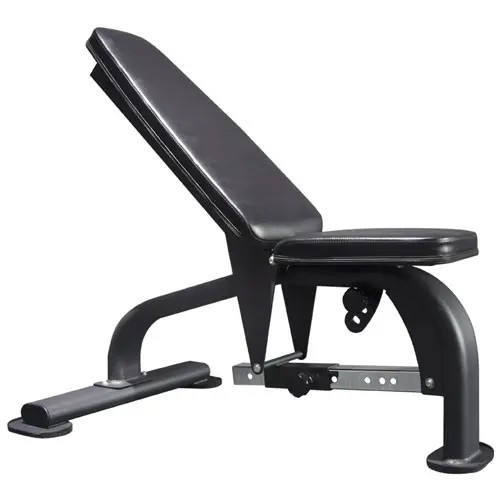
Why Is a Weight Bench So Expensive?
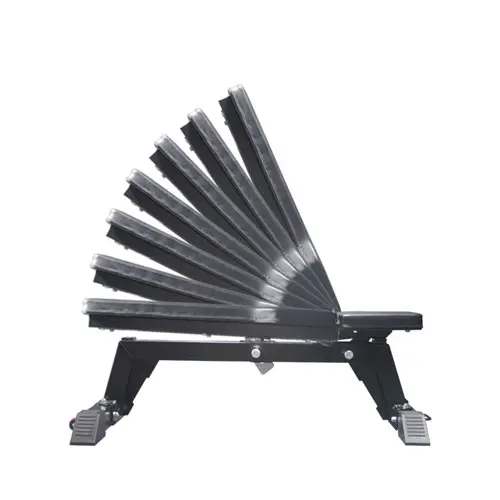
Weight benches can often be surprisingly expensive, especially when you consider that they are relatively simple pieces of equipment. However, the high cost is typically reflective of a combination of factors, including materials, design, functionality, brand reputation, and even the overall manufacturing process. In this explanation, we will explore these various elements to help you understand why weight benches can come with hefty price tags. From the materials used to the technological features incorporated into the design, there are several key reasons for the expense of a weight bench.
Materials and Construction Quality
One of the most significant factors driving up the price of a weight bench is the quality of materials used in its construction. Benches that are built with premium materials such as heavy-duty steel, reinforced frames, and high-density foam padding are more durable and long-lasting, which naturally increases their cost.
- Heavy-Duty Steel Frames: Higher-end weight benches are typically made from stronger steel, providing enhanced stability and durability. These materials are built to handle heavy weights without bending, warping, or breaking over time. The cost of raw materials like steel can also be quite high, contributing to the overall price.
- High-Quality Upholstery: The padding on the bench plays a crucial role in comfort and durability. Premium weight benches often use dense, long-lasting foam with durable vinyl or leather coverings that resist wear and tear. These materials add to the cost due to their durability and ability to withstand repeated use over many years.
The better the materials, the longer the bench will last, and the more you can expect to pay for it.
A weight bench with adjustable features can be much more expensive than a fixed one, as it adds versatility and more complex mechanisms. The ability to adjust the backrest, seat, or even the height of the bench adds functionality but requires additional components and engineering. If you want a bench that provides multiple settings for different exercises, expect to pay more for this added flexibility. Brand reputation is another factor that can contribute to the higher price of a weight bench. Well-known fitness brands with a reputation for quality and durability tend to charge more due to the trust they’ve built with consumers. Moreover, the design and aesthetic elements of the bench can also affect the cost. Paying for a trusted brand often means you’re getting consistent performance and support, but it also drives up the price. Some modern weight benches come equipped with technological innovations and advanced features that are not found in traditional models. These technologies can add significant costs to the bench. Although these advanced technologies enhance the user experience, they come with a significant price tag due to the research and development invested in them. Durability is a critical factor that justifies the price of many higher-end weight benches. A sturdy, long-lasting bench is designed to withstand heavy usage and maintain its structural integrity, even when subjected to daily weight lifting. If you’re investing in a weight bench that will last for a decade or more, you’re paying for long-term quality and peace of mind. The manufacturing process and shipping also play a role in determining the price of a weight bench. Benches made in the United States or other developed countries typically come with higher production costs due to labor, materials, and overhead. Additionally, shipping a large, heavy product to your location can add significant costs to the final price. These additional costs, while not immediately apparent, add up to the overall price tag of a weight bench. The high price of a weight bench can often be attributed to several interconnected factors such as premium materials, advanced features, brand reputation, technological innovations, durability, and manufacturing costs. While you can find budget-friendly options, high-quality weight benches that offer adjustability, longevity, and excellent performance typically come with a higher price tag. It’s important to evaluate your fitness goals, how often you’ll use the bench, and the features you need before making a purchase. If you’re looking for a bench that will last and support a variety of exercises, paying more for a durable, feature-rich model can be a worthwhile investment in the long run.Advanced Features and Adjustability
Brand Reputation and Design
Technology and Innovation
Durability and Longevity
Manufacturing and Shipping Costs
FAQs about Weight Bench
Why are exercise benches so expensive?
Exercise benches can vary significantly in price, often leading potential buyers to wonder why some models are so expensive. Several factors contribute to the cost of exercise benches:
Build Quality and Materials: High-quality benches are made from durable materials, such as heavy-duty steel frames and high-density foam padding. These materials not only ensure the longevity of the product but also provide adequate support during workouts. Cheaper benches may use lower-quality materials that can compromise safety and durability.
Adjustability and Features: Many high-end benches come with adjustable settings that allow users to change the angle for various exercises, such as flat, incline, and decline presses. This versatility enhances the bench’s functionality, allowing for a broader range of workouts. Features such as integrated storage for weights, leg extensions, or built-in safety catches can also increase the price.
Brand Reputation: Established brands with a reputation for quality and performance often charge more for their products. Consumers may be willing to pay a premium for a bench backed by positive reviews and a history of reliability.
Shipping and Assembly Costs: The price of exercise benches may also include shipping fees and the cost of assembly. Some manufacturers offer free shipping, while others may charge extra, which can influence the overall price.
How much weight should I lift for bench press?
Determining how much weight to lift for the bench press is crucial for both safety and effectiveness in your strength training program. The appropriate weight can vary widely depending on several factors, including your fitness level, goals, and experience. Here are some guidelines to help you choose the right weight:
Assess Your Fitness Level: Beginners should start with lighter weights to focus on mastering proper form and technique. It’s often recommended to start with just the barbell (usually 45 lbs or 20 kg) or lighter dumbbells to get accustomed to the movement.
Determine Your Goals: If your goal is to build strength, aim for a weight that allows you to perform 3-5 repetitions with good form. Conversely, if you’re focusing on hypertrophy (muscle growth), select a weight that lets you complete 8-12 repetitions.
Progressive Overload: Gradually increase the weight as you become stronger. A good rule of thumb is to increase the weight by 5-10% once you can comfortably complete your target number of repetitions with your current weight.
Listen to Your Body: It’s essential to pay attention to how your body feels during and after lifting. If you experience pain or discomfort (beyond normal muscle fatigue), consider lowering the weight or reassessing your form.
What is the average weight a person can bench?
The average weight a person can bench press varies widely based on several factors, including age, gender, fitness level, and training experience. Generally, the following averages can be used as a rough guideline:
Beginner Lifters: For individuals new to strength training, the average bench press weight is often between 60-100 lbs (27-45 kg) for men and 30-60 lbs (14-27 kg) for women. Beginners should focus on developing proper form and gradually increasing their strength.
Intermediate Lifters: Those with some experience in weight training may be able to bench press approximately 100-180 lbs (45-82 kg) for men and 60-100 lbs (27-45 kg) for women. At this stage, lifters should be incorporating progressive overload into their training to continue building strength.
Advanced Lifters: Experienced lifters who consistently train may bench press 180 lbs (82 kg) or more for men and around 100 lbs (45 kg) or more for women. Competitive athletes may achieve significantly higher weights depending on their specific training regimens and goals.
What is a good bench to weight?
A good bench-to-weight ratio is an important consideration for lifters aiming to evaluate their strength and track progress in their training. This ratio can help you understand how your bench press performance compares to your body weight, indicating your strength relative to your size. Here’s how to assess what constitutes a good bench-to-weight ratio:
General Bench-to-Weight Ratio:
For beginners, a good starting goal is to bench press their body weight. This means if you weigh 150 lbs, your target would be to bench 150 lbs.
Intermediate lifters often aim to bench 1.5 times their body weight. For example, a person weighing 180 lbs might target a bench press of 270 lbs.
Advanced lifters frequently set their sights on benching double their body weight or more, though this can vary significantly based on individual training backgrounds.
Factors Influencing Ratios:
Individual factors such as age, gender, and overall fitness level will affect what is considered a good bench-to-weight ratio. For instance, male lifters generally have higher average ratios than female lifters, although this gap has been closing as more women engage in strength training.
Body composition also plays a role. Lifters with higher muscle mass relative to body weight may find they can lift heavier weights more easily than those with lower muscle mass.
Tracking Progress:
Regularly assessing your bench press against your body weight can help you gauge strength gains over time. Consider using a training log to track your bench press weight and body weight periodically, allowing you to adjust your training goals accordingly.
Has anyone benched 3x bodyweight?
Yes, there have been cases of people benching three times their bodyweight, though it is incredibly rare. One notable example is powerlifter and former world record holder, Julius Maddox, who has benched 765 pounds at a bodyweight of around 400 pounds, which comes close to a 1.9x bodyweight lift. Benching 3x bodyweight requires an extraordinary combination of strength, technique, and muscle mass. Most competitive powerlifters will focus on lifting around 2x bodyweight as an elite target. While the feat of 3x bodyweight is certainly possible for some individuals, it is not a benchmark widely achieved in the general lifting community, and it remains a highly impressive accomplishment for those who achieve it.
Is a 2x bodyweight bench possible?
Yes, a 2x bodyweight bench press is achievable and represents an exceptional feat of strength. This benchmark is often pursued by elite powerlifters, especially those in the heavier weight classes. For example, a 220-pound man who benches 440 pounds or a 300-pound man who presses 600 pounds has hit this 2x bodyweight mark. Achieving a 2x bodyweight bench press is rare but not impossible. It requires disciplined training, optimal nutrition, and superior genetics. For someone who is training seriously in powerlifting, hitting a 2x bodyweight press is an ambitious but attainable goal with years of focused work. However, it should be noted that it is more common for men at lighter weights to bench 2x bodyweight, as body mass plays a role in the total load someone can lift.
Has anyone ever benched 800 pounds?
Yes, a few individuals have benched 800 pounds, though it’s a rare and historic accomplishment. The most famous person to achieve this feat is American powerlifter, Julius Maddox, who set the world record with a 782-pound bench press in 2021, coming very close to the 800-pound mark. He is considered the strongest bench presser of all time and has made impressive strides in pushing the limits of what is possible on the bench press. As of now, no one has officially benched 800 pounds in a sanctioned competition, but Maddox’s record may eventually be broken. The 800-pound bench press would likely require an exceptional combination of genetics, training, and support from lifting techniques and equipment, especially in competitions.
How long does it take to bench 225?
The time it takes to bench 225 pounds varies greatly depending on a person’s starting point, age, training experience, and genetics. For someone new to lifting, reaching 225 pounds on the bench press might take anywhere from 1 to 3 years of consistent training, particularly for those starting from a beginner level. Individuals who are more experienced in strength training may reach this milestone in a shorter period. Proper form, progressive overload, and recovery all contribute significantly to achieving a 225-pound bench press. Nutrition and rest also play essential roles, as muscle growth and strength development occur outside of the gym. People with higher body weights or those involved in strength training sports like powerlifting may naturally progress more quickly toward this goal compared to those just beginning.
Is 225 a respectable bench?
Yes, bench pressing 225 pounds is considered a respectable achievement, particularly for individuals who are intermediate to advanced in their lifting journey. For men, benching 225 pounds represents a strong foundation, as many novice lifters might struggle to achieve this benchmark. Athletes who regularly lift and train for strength can typically achieve a 225-pound bench press after a couple of years of consistent training. For women, reaching 225 pounds is extraordinary and highly uncommon. While it’s certainly impressive, it is just one marker in a long progression of strength gains, and lifting beyond this weight can still be a significant milestone in a lifter’s career. Competitive powerlifters often aim for much higher lifts, but 225 remains a popular goal for many recreational lifters.
How much should a 55-year-old man bench press?
The amount a 55-year-old man should bench press depends on several factors, including his training experience, overall fitness level, and health. For a man in his mid-50s who is in good shape but has never lifted weights, it may take several months to a year to bench press an average weight (135–185 pounds). However, a healthy, experienced lifter in their 50s could aim for a 1.5x bodyweight press or more, with a 225-pound bench press being an impressive target. It’s crucial to maintain proper form and avoid overexertion to prevent injury. Senior lifters should focus on mobility, joint health, and progressive strength training that respects their body’s limits while still challenging them. Starting with lighter weights and gradually increasing the load over time will lead to steady progress.
How rare is a 275 bench?
A 275-pound bench press is relatively rare but still achievable for dedicated lifters, especially those who have been training for years. It is often considered an advanced milestone for those who are serious about strength training. For someone weighing between 160–200 pounds, hitting 275 pounds could be a goal that requires disciplined work and patience. For beginners or intermediate lifters, reaching 275 pounds might take several years of consistent training, while elite powerlifters can achieve this sooner. It’s more common in men in the 200–250-pound weight range, but still a noteworthy accomplishment that reflects dedication and proper training techniques. For women, a 275-pound bench press is exceptionally rare. While it’s not an everyday lift, achieving a 275-pound bench press places lifters in the upper echelon of strength.
Is 100 lbs bench press good?
For a beginner, especially a teenager or someone who is new to weight training, a 100-pound bench press is a solid start. It shows that the individual has developed enough upper body strength to handle a meaningful amount of weight. For men who are just starting, 100 pounds might be on the lower end, but it’s still a good starting point for building strength. For women, a 100-pound bench press is often above average, especially for beginners. However, lifting progress depends on age, body weight, and lifting history. It’s important to focus on gradual progress through consistent training, good nutrition, and proper technique. The key is not just hitting 100 pounds but continuing to improve over time while avoiding injury.
Is 100 pound bench press good for a 14-year-old?
Yes, a 100-pound bench press is quite good for a 14-year-old, especially considering that many teenagers at this age are still developing their strength and skills. Depending on their body weight, a 100-pound bench press could be impressive for a beginner lifter. Teenage lifters should focus on proper form and safety rather than trying to max out too early. At 14, the body is still growing, so it’s essential to gradually build strength while avoiding undue stress on the joints and tendons. Progressive overload is key to increasing strength in a safe manner. For a more experienced 14-year-old lifter, reaching 100 pounds is within reach, but it’s also essential to prioritize overall development, including flexibility, mobility, and conditioning.
Is 200 lbs a good bench?
A 200-pound bench press is a solid and respectable achievement, especially for someone in the intermediate level of training. For many men, benching 200 pounds represents a milestone that showcases a decent level of upper body strength. For those in the 150–200-pound weight class, benching 200 pounds could be indicative of significant progress and commitment to strength training. For beginners, reaching a 200-pound bench press might take several years of consistent effort. Elite lifters in the sport of powerlifting will often press significantly more, but for recreational lifters, hitting the 200-pound mark demonstrates a strong foundation in strength. Proper form, progressive overload, and nutrition are essential to progress past this benchmark to higher numbers.
Can a human bench press 1000 pounds?
Currently, no human has been able to bench press 1,000 pounds, and it is widely considered an extremely unlikely feat due to the limits of human strength and anatomy. The heaviest bench press on record is around 800 pounds, set by powerlifter Julius Maddox. To bench 1,000 pounds, an individual would need to have extraordinary genetics, a massive amount of muscle mass, and years of specialized training. Even with advanced lifting techniques, supportive gear (such as a bench press shirt), and nutrition, reaching the 1,000-pound mark would require surpassing known physiological limits. It’s possible that, with the right advancements in training, equipment, and recovery, such a lift could be seen in the future, but as of now, it’s far beyond the capabilities of most lifters.
Can an untrained man bench 135?
Yes, an untrained man can bench press 135 pounds, but it largely depends on his body weight, natural strength, and overall fitness level. For someone who is in decent physical shape or has a background in sports or manual labor, lifting 135 pounds might not be too challenging, especially for those in the 180–220-pound range. However, for someone who has never lifted weights or has limited upper body strength, pressing 135 pounds might be difficult at first. It’s important for beginners to start with lighter weights to develop proper form, avoid injury, and build up strength progressively. Bench pressing 135 pounds is a common early goal for those new to weight training, and with consistent training, it can usually be achieved within a few months.
What percent of humans can bench 135?
It is estimated that a significant percentage of men can bench press 135 pounds, especially those who are in average physical condition. Among the general population, the figure is likely to be around 50-70%, with variables such as age, fitness level, body weight, and physical activity influencing this number. Men who engage in regular physical activity or sports, even if not specifically lifting weights, will often be able to bench press 135 pounds. However, for women or individuals who are less physically active, benching 135 pounds can be more difficult and less common. Strength training significantly increases the chances of being able to press this weight, and the more consistent one’s training, the more likely they are to achieve or surpass this benchmark.
Can anyone bench 700 pounds?
No, not everyone can bench press 700 pounds. Bench pressing 700 pounds is a feat that requires extreme strength, training, and genetics. As of now, very few people have achieved this in the sport of powerlifting. Julius Maddox holds the world record for the heaviest bench press at 782 pounds, and only a handful of elite athletes in the powerlifting community have come close to lifting 700 pounds. Most people, even those who are highly trained, would struggle to approach this weight. To bench press 700 pounds, an individual would need immense muscle mass, an optimal lifting technique, specialized training, and possibly the use of supportive equipment (such as a bench press shirt). While it is an extraordinary accomplishment, it remains outside the reach of the vast majority of humans.
Can you naturally bench 315?
Yes, it is possible for some individuals to naturally bench press 315 pounds, but it’s rare. Achieving a 315-pound bench press typically requires years of dedicated strength training, good genetics, and significant muscle development. Individuals with a natural predisposition for strength and muscle gain may reach this goal faster, but for most, it takes consistent training over many years. Those who can naturally bench 315 pounds usually weigh more (in the 200–250-pound range) and have developed upper body strength through years of lifting or athletics. Proper technique, progressive overload, nutrition, and recovery are key factors in achieving this goal. Although reaching a 315-pound bench press is difficult for most people, it’s certainly possible with hard work and proper training.
Do you really need a weight bench?
While you don’t technically need a weight bench to bench press, having one provides several benefits. A weight bench helps stabilize the body, allowing you to focus on proper form and technique, which is essential for lifting heavier weights safely. It also allows you to perform exercises like incline, decline, or flat bench presses, each of which targets different parts of your chest and shoulders. While alternatives like floor presses can work in a pinch, using a bench makes the exercise more effective and safer. If you’re training in a commercial gym, a quality weight bench is a valuable tool for anyone looking to build strength and muscle in the upper body. So while not absolutely necessary, a weight bench is highly recommended for maximizing bench press performance.
How much is a good bench for your weight?
A good bench press for your weight largely depends on your experience level, age, and overall fitness. For a healthy, intermediate-level lifter, pressing 1.5 to 2 times your body weight is a solid benchmark. For example, if you weigh 180 pounds, a 270–360-pound bench press would be considered excellent. Beginners should aim for pressing their body weight or slightly more, while advanced lifters can target lifting well over double their body weight. However, it’s essential to approach these goals progressively, ensuring proper form and injury prevention throughout training. Keep in mind that strength is relative and not every individual will achieve the same levels based on body type or training history. Focus on steady progress and strength improvements, and always listen to your body to avoid overexertion.
How to pick a weight bench?
When choosing a weight bench, several factors should be considered to ensure it meets your needs. First, assess the type of bench you need: flat, incline, or adjustable. Adjustable benches offer more versatility, as they allow you to target different muscle groups by changing the angle of the bench. Look for a bench with sturdy construction made from high-quality materials, like steel, to ensure safety while lifting heavy weights. Check the weight capacity to ensure it can handle your lifting goals. Comfort is also key; a well-padded bench with a non-slip surface will provide stability and support during lifts. Additionally, consider the size and portability if you have limited space. Lastly, if possible, test the bench for stability and comfort before purchasing. A good weight bench will provide durability, support, and flexibility to help you maximize your workouts.
Is 90 lbs bench press good?
A 90-pound bench press can be considered good depending on your experience level, body weight, and fitness goals. For a beginner, especially someone new to strength training, benching 90 pounds can be a solid starting point. If you weigh less than 120 pounds and are still developing strength, lifting 90 pounds might be an appropriate challenge. However, for someone who has been training for a while, this weight might be on the lighter side. The key to a good bench press is consistent progression, proper form, and developing overall upper body strength. If 90 pounds feels easy, consider increasing the weight gradually while maintaining good form. Additionally, incorporating variations like incline and decline bench presses or dumbbell presses can help improve overall benching ability. Strength varies between individuals, so focus on personal improvement rather than comparison.
Is a 125 bench good for a 15-year-old?
A 125-pound bench press for a 15-year-old is generally a respectable lift, but whether it’s “good” depends on body weight, training experience, and athletic background. If you are just starting out, benching 125 pounds is above average for most teenagers and indicates a solid foundation of upper body strength. If you weigh around 130–150 pounds, this is a decent lift for your weight class. However, if you’re an advanced lifter or an athlete training regularly, you might aim for a higher number over time. Proper form, gradual progression, and balanced training (including back, shoulders, and triceps) are crucial for long-term improvement. At 15, your body is still growing, and strength gains will come naturally with consistent training. If you’re looking to increase your bench, focus on progressive overload, a proper diet, and enough recovery time between workouts.
Is a 165 bench good?
A 165-pound bench press is quite good for many lifters, especially for those who weigh around 150–180 pounds and have some experience with strength training. If you’re a beginner, reaching a 165-pound bench press is an impressive milestone. For intermediate lifters, this weight is a solid indicator of upper-body strength, particularly if performed with proper technique. However, if you’re an advanced lifter or competing in powerlifting, you may aim for a higher number relative to your body weight. Factors such as training consistency, nutrition, and muscle composition influence bench press strength. If 165 pounds is challenging for you, focusing on progressive overload—gradually increasing weight over time—can help improve your performance. Additionally, incorporating supporting exercises such as triceps dips, push-ups, and overhead presses can enhance pressing power. Overall, a 165-pound bench press is a solid achievement for many lifters.
Is benching 175 good?
Benching 175 pounds is a strong lift for many lifters, particularly those weighing between 140 and 180 pounds. For beginners, this is an advanced achievement that showcases solid upper-body strength. For intermediate lifters, 175 pounds is a respectable benchmark that indicates consistent training and muscle development. If you’re an advanced lifter or an athlete, you may aim for a higher number to improve performance. Strength standards vary based on factors such as weight, experience, and training frequency. A good way to gauge your progress is to compare your bench press to your body weight. If you can bench your body weight or more, you are doing well. To continue improving, focus on technique, progressive overload, and incorporating accessory exercises like triceps extensions, shoulder presses, and lat pulldowns. If your goal is to reach 200+ pounds, gradually increasing weight and ensuring proper recovery will help.
How much should I bench if I weigh 160?
The ideal bench press for someone weighing 160 pounds depends on experience and fitness level. A beginner may start around 95–135 pounds, while an intermediate lifter might bench between 160 and 200 pounds. Advanced lifters could press 225 pounds or more. A common benchmark is being able to bench your own body weight, which means pressing 160 pounds is a good goal for many lifters. However, strength varies between individuals due to factors like muscle mass, limb length, and training background. If you’re aiming to improve your bench press, focus on progressive overload by gradually increasing weight over time. Proper technique, nutrition, and rest play essential roles in maximizing strength. To boost your bench, incorporate accessory exercises like incline bench press, dips, and triceps extensions. Strength training consistency and proper recovery will help you increase your max bench press safely and effectively.
Are all bench bars 45 pounds?
No, not all bench press bars weigh 45 pounds. While the standard Olympic barbell used in most gyms weighs 45 pounds (20 kg), there are other types of bars with different weights. Some common alternatives include:
- Standard Bars – Some gyms have lighter barbells, typically 35 pounds or even 15–25 pounds for beginners.
- EZ Curl Bars – Designed for arm workouts, these bars usually weigh between 15–35 pounds.
- Safety Squat Bars – These bars can weigh up to 60–70 pounds.
- Fixed Weight Bars – Many gyms have preloaded bars ranging from 20 to 110 pounds for easy access.
When lifting, always check the bar’s weight before adding plates, as some specialty bars are heavier or lighter than the standard Olympic bar. If you’re unsure, ask gym staff or look for labeled weight markings on the bar itself.
Is 145 a decent bench?
A 145-pound bench press is a solid lift depending on your experience and body weight. For beginners, reaching 145 pounds is a good milestone that shows progress in upper-body strength. If you weigh around 130–160 pounds, benching 145 is considered decent, especially if you can do multiple reps with good form. For an intermediate lifter, 145 pounds may be on the lower end, but it still represents a good level of strength. If you weigh significantly more than 160 pounds, you might want to work towards benching at least your body weight to develop better proportional strength. To improve your bench, incorporate exercises like incline presses, triceps dips, and shoulder presses. Progressive overload, proper form, and consistent training will help you increase your max bench over time. Whether or not 145 pounds is “good” depends on your goals, body weight, and training background.
Is a 30 or 45 bench press better?
A 30-pound bench press is suitable for beginners, those rehabbing injuries, or individuals looking for light endurance training. It allows for higher reps, which can help build muscular endurance and improve technique without the risk of injury. On the other hand, a 45-pound bench press (assuming you mean the weight of the bar alone) is the standard starting weight for most lifters. It’s a better option for those focusing on strength and muscle growth, as it provides more resistance. If your goal is to build strength and eventually lift heavier weights, starting with a 45-pound bench press (or adding weight to a 30-pound bar) is recommended. If you’re a beginner struggling with a 45-pound bar, using a 30-pound one initially can help develop proper form. Ultimately, the best choice depends on your strength level, experience, and fitness goals.
